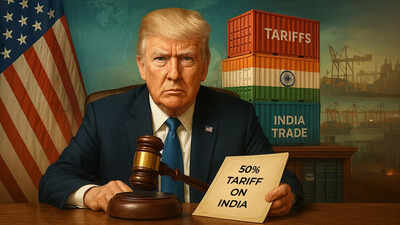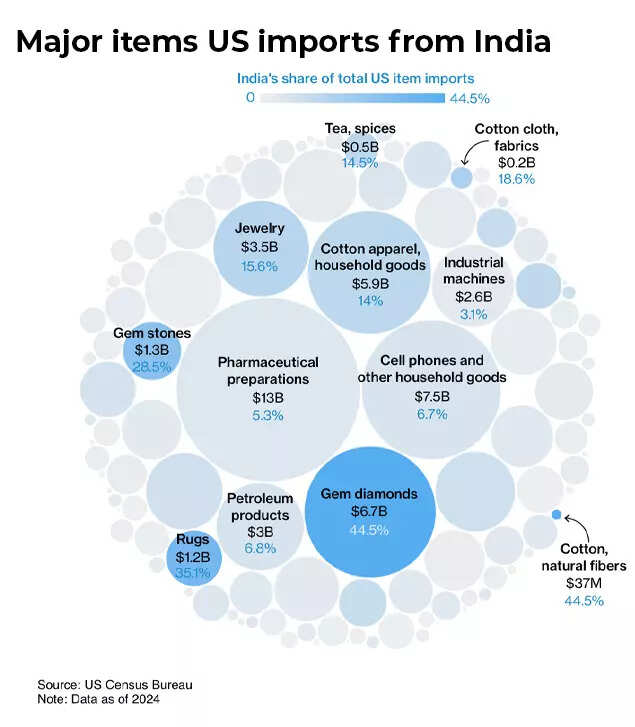India not bowing to Trump’s pressure! As 50% US tariffs kick in, here’s how government aims to counter impact – from GST cuts to next-gen reforms

India is bracing to face 50% US tariffs from August 27, after the Donald Trump administration notified that 25% additional tariffs on Indian goods will come into effect from Wednesday. India is now among the countries facing the highest Trump tariffs.Having drawn its red lines on the trade deal, asserting its right to protect national interests and safeguard its strategic autonomy in buying Russian crude oil, India is looking to counter the impact of the high tariffs.The government is accelerating policy reforms, including GST restructuring, to bolster economic confidence and growth. Since July, Trump’s tariff threats have prompted New Delhi to address complex reforms that businesses and economists consider crucial for attracting investment.In a recent meeting with his Economic Advisory Council, Modi sought policy advice regarding living standards and ease of doing business.Also Read | ‘Strategic shock’: Donald Trump’s tariffs to hit 66% of India’s exports to US; China, Vietnam set to gain
PM Modi’s firm stance & push for ‘swadeshi’
PM Narendra Modi has highlighted concerns about “selfcentred economic policies” whilst advocating Swadeshi principles. He called upon citizens and businesses to exclusively purchase and promote ‘Made in India’ products to achieve national self-reliance and development. “I am asking our shopkeepers and traders. Do not sell foreign goods. This will provide a huge boost to the Make in India movement. Small contributions by each one will go a long way in achieving self-reliance,” the PM has said, maintaining his firm stance against external pressures.Modi’s reference to “self-centered economic policies” appeared to address Washington’s trade approach.Without naming specific parties, Modi emphasised his commitment to protecting domestic interests. “For Modi, the interests of farmers, cattle rearers and small-scale industries are paramount. Pressure on us may increase, but we will bear it all,” the PM affirmed.
GST cuts to boost domestic consumption
The GST structure is set to undergo changes, featuring a simplified two-tier system instead of the current four tiers. Items currently taxed at 12% and 28% will see reductions to 5% and 18%, respectively. A group of state finance ministers has endorsed this proposal, which awaits final approval from the GST Council, headed by Finance Minister Nirmala Sitharaman.The Modi government anticipates that reduced GST rates will encourage increased consumer expenditure, particularly on essential items such as food and clothing. According to IDFC First Bank’s analysis, this tax reduction could enhance nominal GDP growth by 0.6 percentage points within a 12-month period.Also Read | Explained: How will Donald Trump’s tariffs impact India’s exports to US? These sectors will be the hardest hitThe upcoming GST Council meeting on September 3 and 4 will consider proposals to reduce tax rates on various items including cement, commonly used services like salon and beauty parlours, and insurance products for individuals.Additionally, there is a proposal to bring all food and textile items under the 5% tax bracket to eliminate classification issues and make the tax structure more straightforward, according to sources who spoke to TOI.

Major items US imports from India
Next-generation reforms loading
PM Modi spoke of “next-generation reforms” in his August 15 Independence Day address. This could include policy adjustments to lower business compliance expenses and eliminate unnecessary legislation.According to a Bloomberg report, a government report released this year highlights how certain factory regulations make operating two facilities with 150 workers each more cost-effective than managing a single unit with 300 employees, hindering operational efficiency. Current labour regulations mandate double wages for overtime work, leading many employees to seek additional hours through informal arrangements.Modi has established two high-level committees to address these policy requirements. One group, which conducted its initial meeting last week under Cabinet Secretary TV Somanathan’s leadership, will concentrate on state-level deregulation, an official told Bloomberg.The second committee, headed by Rajiv Gauba from the Niti Aayog think tank, will develop proposals for the next-generation reforms outlined by Modi, the report said.Also Read | ‘Trump’s way of dealing with world a departure’: Jaishankar says recent experience taught India to not rely on a single market; asserts strategic autonomyTalking about the reforms push, commerce minister Piyush Goyal recently said that several options are being evaluated.“We are looking for ideas big and small…we would like to decriminalise as many laws as we can, reduce the regulatory burden on industry. Maybe we won’t be able to deliver 100% but we’ll make a sincere effort…We have decriminalised 355 sections in Jan Vishwas Bill 2.0, I want to take it up to 1,355. The select committee is going to be seeking suggestions. If required, I’ll introduce a completely new bill,” he said.Regarding sector-specific policies, especially for labour-intensive industries, authorities are reviewing GST restructuring possibilities. “We’ll see how we can support many of these labor intensive sectors, like food processing, textile through the GST framework to give a boost to domestic demand. Our ministry and different line ministries are already looking at complementarity of our strength areas with other economies,” he said.
RBI ready to support
RBI governor Sanjay Malhotra has said that the central bank stands ready to protect the economy from the consequences of the US’s 50% tariff implementation on Indian exports. He also highlighted initiatives to promote local currency trade as part of the rupee’s internationalisation strategy.“RBI has always been very proactive in whatever needs to be done for the betterment, advancement, and growth of our country,” Malhotra said.Speaking about the US tariff, he elaborated: “Post the tariff announcement in April, we had projected downwards our GDP growth by 20 basis points. There has been an additional 25% tariff making it 50%. It is set to kick in, in another couple of days. We are hopeful trade negotiations will play out and also expect that the impact will be minimal.”Regarding the strategic initiative to internationalise the rupee, Malhotra said: “This is an important area on which RBI has been working for a long time. It’s important for countries to develop trade in local currencies. And so the RBI has also been moving in this direction. Today, we have agreements with four countries: Maldives, Mauritius, Indonesia and UAE, and trade is starting. It has certainly helped industry and the economy as a whole because it cushions us from the volatility of foreign exchange price movements.“Also Read | ‘Funny that pro-business administration accusing…’:India’s clear message to US on buying Russian crude oil, trade deal ahead of Trump’s 50% tariffs
Exports schemes & Free Trade Agreements
The government is exploring financial aid options for exporters to reduce the impact of tariffs. Industries anticipated to face significant challenges include textiles, jewellery and footwear.Senior officials from the Prime Minister’s Office, alongside representatives from commerce and finance ministries, are convening to evaluate potential solutions, including reduced-interest financing and assistance in exploring alternative markets, according to informed sources.Trade associations anticipate that tariff increases might impact approximately 55% of India’s merchandise exports to the U.S., valued at $87 billion, whilst giving an advantage to rival nations including Vietnam, Bangladesh and China.“The U.S. customers have already stopped new orders. With these additional tariffs, the exports could come down by 20-30% from September onward,” said Pankaj Chadha, president, Engineering Exports Promotion Council.In response, Chadha noted that the government is looking at monetary assistance, comprising enhanced subsidies for bank borrowings and backing for market diversification should financial setbacks occur.In the meantime, the government is also looking to finalise Free Trade Agreements (FTAs) with major economies in order to boost exports and diversify markets for India’s goods.
India’s resilient economy
Most economists and institutions are of the view that the impact of tariffs would be minimal to moderate on India’s GDP growth. The estimates range from 0.20% to 0.90%, with the latter seen as a worst case scenario.According to a Bloomberg report, at the Economic Advisory Council meeting, economists expressed confidence in achieving 6.5% growth by March 2026, supported by low inflation and anticipated interest rate reductions. The discussions acknowledged the necessity for policy adjustments to stimulate economic demand.India’s economic fundamentals remain stable, providing the government latitude for implementing challenging reforms. Inflation stands at an eight-year low, whilst Standard & Poor’s has upgraded India’s credit rating for the first time in 18 years. Additionally, the financial sector’s cleanup has resulted in strengthened banking institutions.“The indicators of macro-stability show excellent condition,” noted Sanjeev Sanyal, who serves on Modi’s Economic Advisory Council. “This provides an opportunity to strengthen the reform agenda, establishing groundwork for future periods of substantial growth.”India’s economic growth relies primarily on domestic consumption rather than exports, making consumer and business confidence crucial growth factors. Whilst the United States remains India’s largest export destination, receiving $87.4 billion in goods during 2024, this represents merely 2% of India’s GDP, with private consumption accounting for approximately 60% of the country’s gross domestic product.




